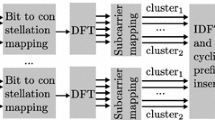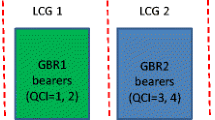Abstract
Resource allocation in Long Term Evaluation (LTE) uplink is challenging because of two reasons: (1) it requires contiguous resource block allocation and (2) high complexity due to per user based power allocation among resource blocks. This paper presents a low complexity, optimal power resource allocation scheme for LTE uplink. We propose Virtual Cluster-based Proportional Fairness scheme that exploits the link adaptation information available at MAC layer to form virtual clusters. The distributed proportional fair scheduler ensures a minimum throughput for all users in the coverage area by assigning contiguous resource blocks, proportional to the throughput and the number of users in a particular cluster or group. Then, it allocates power to each resource block through water-filling algorithm which gives 20.2 % increase in average user throughout compared to equal power allocation. Simulations have been performed using practical scenarios of uniformly distributed users in Rician fading environment. Mathematical framework has been devised for network planning to get the best possible fairness with promising level of quality of service.













Similar content being viewed by others
References
Requirements for further advancements for Evolved Universal Terrestrial Radio Access (E-UTRA) (LTE-Advanced) (Release 10). No. 3GPP TS 36.913, 2011.
Further advancements for E-UTRA physical layer aspects (Release 9). No. 3GPP TS 36.814, Mar. 2010.
Lim, J., Myung, H., Oh, K., & Goodman, D. (2006). “Channel dependent scheduling of uplink single carrier fdma systems”, In Proc. IEEE VTC’06 Fall, vol. 1, pp. 1–5.
de Temino, L. R. et al., (2008). “Channel-aware scheduling algorithms for SC-FDMA in LTE uplink”, In Proc. IEEE PIMRC, vol. 1, (French Riviera, France), pp. 1–6.
Ng, C. Y., & Sung, C. W. (2008). Low complexity subcarrier and power allocation for utility maximization in uplink ofdma systems. Wireless Communications, IEEE Transactions on, 7, 1667–1675.
Al-Rawi, M., Jantti, R., Torsner, J., & Sagfors, M. (2007). “Opportunistic uplilnk scheduling for 3G LTE systems”, In Innovations in Information Technology, 2007. IIT ’07. 4th International Conference on, pp. 705–709.
Chang, C.-H., Chao, H.-L., & Liu, C.-L. (2011). “Sum throughput-improved resource allocation for LTE uplink transmission”, In Vehicular Technology Conference (VTC Fall), 2011 IEEE, pp. 1–5.
Lee, S.-B., Pefkianakis, I., Meyerson, A., Xu, S., & Lu, S. (2009). “Proportional fair frequency-domain packet scheduling for 3gpp LTE uplink”, In INFOCOM 2009, IEEE, pp. 2611–2615.
Yaacoub, E., & Dawy, Z. (2009). “A game theoretical formulation for proportional fairness in lte uplink scheduling”, In Proc. IEEE WCNC, vol. 1, (Hungary), pp. 1–5.
Huang, J., Subramanian, V. G., Berry, R. A., Agrawal, R., & Berry, R. (2009). Joint scheduling and resource allocation in uplink ofdm systems for braodband wireless access networks. IEEE Journal on Selected Areas in Communications, 27(2), 226–234.
Awad, M. K., Mahinthan, V., Mehrjoo, M., Shen, X. S., & Mark, J. W. (2010). A dual-decomposition-based resource allocation for ofdma networks with imperfect csi. IEEE Transaction on Vehicular Technology, 59, 2394–2403.
Wong, I., Oteri, O., & McCoy, W. (2009). Optimal resource allocation in uplink SC-FDMA systems. Wireless Communications, IEEE Transactions on, 8, 2161–2165.
Wong, I., & Evans, B. (2008). Optimal downlink OFDMA resource allocation with linear complexity to maximize ergodic rates. Wireless Communications, IEEE Transactions on, 7, 962–971.
Wang, X., & Giannakis, G. (2008). “Ergodic capacity and average rate-guaranteed scheduling for wireless multiuser OFDM systems”, In Information Theory, 2008. ISIT 2008. IEEE International Symposium on, pp. 1691–1695.
El-Hajj, A., Yaacoub, E., & Dawy, Z. (2009). “On uplink OFDMA resource allocation with ergodic sum-rate maximization”, In Personal, indoor and mobile radio communications, 2009 IEEE 20th international symposium on, pp. 276–280.
Ahmed, I., Mohamed, A., & Shakeel, I. (2010). “On the group proportional fairness of frequency domain resource allocation in L-SC-FDMA based LTE uplink”, In GLOBECOM Workshops (GC Wkshps), 2010 IEEE, pp. 1312–1317.
Evolved Universal Terrestrial Radio Access (E-UTRA); Physical layer procedures. No. 3GPP TS 36.213 V9.2.0 (2010–06), 2010.
Khan, F. (2009). LTE for 4G mobile broadband air interface technologies and performance. Cambridge, New York: Cambridge University Press.
Song, G., & Li, Y. (2005). Utility-based resource allocation and scheduling in OFDM-based wireless broadband networks. Communications Magazine, IEEE, 43, 127–134.
Singh, V., & Sharma, V. (2006). Efficient and fair scheduling of uplink and downlink in IEEE 802.16 OFDMA networks, in Wireless Communications and Networking Conference, 2006. WCNC 2006. IEEE, 2, 984–990.
Goldsmith, A. (2005). Wireless Communications. UK: Oxford University Presss.
Myung, H., Lim, J., & Goodman, D. J. (2006). Single carrier fdma for uplink wireless transmission. IEEE Vehicular Technology Magzine, 1(3), 30–38.
Cioffi, J. M. (2005). Lecture notes for advanced digital communications (pp. 285–309). Stanford: Stanford University.
Gao, L., & Cui, S. (2008). Efficient subcarrier, power, and rate allocation with fairness consideration for OFDMA uplink. Wireless Communications, IEEE Transactions on, 7, 1507–1511.
Goldsmith, A., & Chua, S.-G. (1997). Variable-rate variable-power MQAM for fading channels. Communications, IEEE Transactions on, 45, 1218–1230.
Lim, J., Myung, H., Oh, K., & Goodman, D. (2006). “Proportional fair scheduling of uplink single-carrier FDMA systems”, In Personal, indoor and mobile radio communications, 2006 IEEE 17th international symposium on, pp. 1–6.
Munz, G., Pfletschinger, S., & Speidel, J. (2002). “An efficient waterfilling algorithm for multiple access OFDM”, In Global telecommunications conference, 2002. GLOBECOM ’02. IEEE, vol. 1, pp. 681–685 .
Jain, R., Hawe, W., & Chiu, D. (1984). “A quantitative measure of fairness and discrimination for resource allocation in shared computer systems”, DEC-TR-301.
Acknowledgments
This work was made possible by grant number NPRP 5-782-2-322 from the Qatar National Research Fund (a member of Qatar Foundation). The statements made herein are solely the responsibility of the authors. This work was done while Irfan Ahmed was a postdoc at the Computer Science and Engineering Department, Qatar University, Doha, Qatar.
Author information
Authors and Affiliations
Corresponding author
Appendices
Appendix 1: Number of RB in a group
In order to ensure the fairness with minimum guaranteed throughput, the number of RBs in a group should be proportional to the group’s modulation scheme and the number of users in that group, i.e.,
where \(f(M_{K_{i}})\) is modulation dependent function and \(g(K_{i})\) is number of users dependent component. LTE-A supports QPSK, 16, and 64 QAM in the uplink. Our proposed scheme divide the users in three groups \(K_{1}\), \(K_{2}\), and \(K_{3}\) corresponding to QPSK, 16, and 64 QAM, respectively. eNB assigns the QPSK modulation to the UEs with low SNR and 64 QAM to the UEs with high SNR. To get the comparable throughput for UEs in group \(K_{1}\) and \(K_{2}\) we need more RBs. For example, one subcarrier allocated to UE in group \(K_{3}\) gives baud rate of 6 bits per symbol where as it gives 4 bits per symbol and 2 bits per symbol in case of 16 QAM and QPSK, respectively. In order to get the same throughput we need to allocate RBs in the following proportion
This expression assigns the fair proportion of RBs to users in different groups as shown in Table 1.
Furthermore, the number of RBs for a particular group should be proportional to the number of users in that group. To realize this fact we introduce the following function
Substituting (23) and (24) in (22), we get the expression (11). Example:- \(N=25\), \(K_{1}=7\), \(K_{2}=2\), and \(K_{3}=1\), then using Eq. (11), we get
-
\(N_{K_{1}}=21\)
-
\(N_{K_{2}}=3\)
-
\(N_{K_{3}}=1\)
which is the fair distribution of RBs amongst the three groups.
Appendix 2: Complexity order
The proposed algorithm first determines the number of RCs and the number of RBs per RC for each group, then within the group it performs a linear search on the users and RCs in order to find the user-RC pair that maximizes the utility function. For proposed algorithm, the result of [9, (12) modifies to the following:
where \(q_{i}\) and \(r_{i}\) are quotient and remainder from \(N_{K_{i}}/K_{i}\), respectively, and \(N_{RC,K_{i}}\) is the number of RCs allocated to \(K_{i}\) group. From the elementary calculus,
therefore, our proposed algorithm provides a gain of at least \(2\left( \frac{N_{K_{1}}}{q_{1}}\frac{N_{K_{2}}}{q_{2}}+\frac{N_{K_{2}}}{q_{2}}\frac{N_{K_{3}}}{q_{3}}+\frac{N_{K_{1}}}{q_{1}}\frac{N_{K_{3}}}{q_{3}}\right) \) (when \(r_{i}=0\)).
Rights and permissions
About this article
Cite this article
Ahmed, I., Mohamed, A. Power control and group proportional fairness for frequency domain resource allocation in L-SC-FDMA based LTE uplink. Wireless Netw 21, 1819–1834 (2015). https://doi.org/10.1007/s11276-014-0845-4
Published:
Issue Date:
DOI: https://doi.org/10.1007/s11276-014-0845-4




